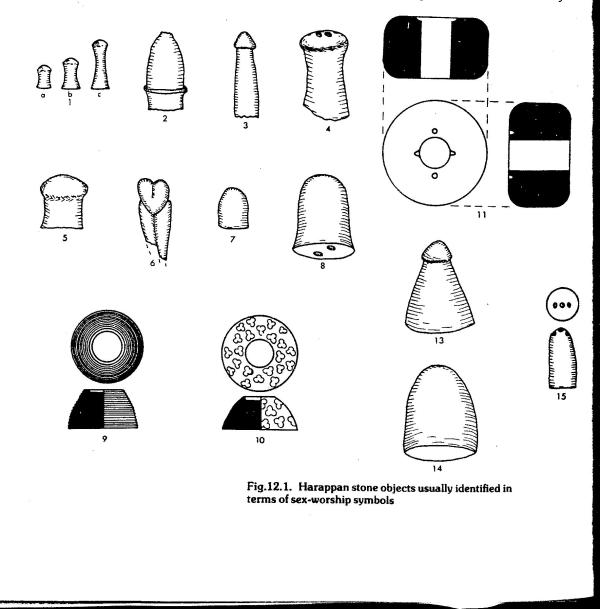
Religious belief of Indus valley people remains a puzzle until today. John Marshal, Director General of Archaeology made some sweeping statements about certain objects he discovered in Mohenjo-Daro and misled the world. He was very unprofessional and forgot to mention where these objects were discovered. Archaeologists have to record the layers or the areas from where the objects were recovered.
He described some objects as symbols of phallic worship. He said the circular stone objects were representations of female genital organs (Yoni) and lingam shaped objects were male organs. Those were up to two feet in height. Marshal classified these objects into three groups: Lingas, Baetylic Stones and Ring Stones. No information is published to show where they were found. Neither Mackay nor Vats (later excavators) gave any information or new finds in their reports.
Since Marshal and Mortimer Wheeler saw everything through the coloured glasses fitted with Aryan-Dravidian lenses, their vision was distorted.
Later scholars pointed out the linga stones may be gamesmen or weights. Ring Stones might have been used to erect pillars or used for astronomical calculations. Since they did not find anything like this anywhere else in further excavations they even questioned the statement ‘’Phallic worship was an important element of Harappan religion’’.
Baetylic stones are roughly shaped stones held sacred or worshipped as of divine origin Marshal’s categorization of some stones as Lingas and some others as baetylic stones was not accepted by other scholars. Indus Valley had no temples where as other ancient civilizations had places of worship. Vedic civilization had no temples. Mortimer Wheeler and others also said that this type of Linga- Yoni worship is Non Aryan. Strange thing about this is all the words such as Linga, Yoni, Pasupati are all Sanskrit words. In Sangam Tamil Literature there was no mention of Shiva, Linga or Yoni. Words such as Shiva, Linga came very late in Tamil literature. Tamil saints addressed Shiva as ARYAN and called him Oh, Reddish one! Going by this no one will call him a Dravidian! Scholars who said that they were practised more in South India left a wrong impression. In fact Tamils followed and translated verbatim whatever said about Shiva in Vedas. Ancient Tamil literature did not use the word Shiva or Pasupati, but used the Vedic expressions such as blue throated, three eyed etc. They also did not fail to say that Shiva lived in Himalayan Kailash! All these things came as slap on the faces of supporters of the racist theory.

More Sex Symbols
Even the Pasupati seal discovered by the early researchers are found in Bahrain and Gundestrup cauldron found in Denmark. It is not unique to Indus Valley.(See my early posts for details and pictures).Marshal’s hypothesis on Proto Shiva seal was wrong. The figure in the Harappan seal is ithyphallic, sitting cross legged and wide armed in the yogic Padmasana.
A female deity is shown in one of the Harappan seal with a tree issuing out of her womb and two rampant tigers standing as guards on either side. P Jayakar has described this seal in a nice way:
‘’From her womb a plant springs, straight and lithe, with its fine leaves uprising and auspicious. The earth is the great yoni. The woman’s body in the Indus seal is the earth bound root, the fecundating source. The arms of the inverted figure are stretched to touch the knees as in yogasanas. The rampant tigers, guardians of initiation, protect the mysteries and the immense magic creation. The tigers are separated from the Earth Mother by the Indus valley script, a mantra or protection.

Lajja Gauri statue from Nepal
Some scholars have identified this deity with Lajja Gauri worshipped in different parts of India. Nude goddess legs apart showing her vulva as an invitation to sexual act is a universal representation in the civilizations of the fertility cult.
Unlike other ancient civilizations, Indus valley had no temples or places of worship. It was like temple less Vedic civilization. Pupul Jayakar in her book ‘The Earth Mother’ interpreted the fish symbol with a dot as Yoni in the seal where a big goat was brought in front of a deity probably for sacrifice.
Marshal jumped to a conclusion that linga –yoni shaped stone objects are sexual symbols. But throughout his report he confused everyone saying ‘’may be they are’’, ‘’may be they are all not sexual objects’’. This is a cunning way of creating doubts in the minds of people—similar to divide and rule policy of the foreigners!
Tamils who write about Indus Valley in their blogs do not know much about other seals where lot of rituals are depicted with tiger goddess and others. Sangam Tamil literature mentions Himalayas and Ganges as holy places. They never said anything about Indus River or Punjab. All their expeditions were to the Himalayas. They knew Kailash, abode of Lord Shiva, very well. It is doubtful that the ancient Tamils knew about Indus valley at all. Though we find the word Yavana, it meant only Romans in ancient literature. Later the meaning slightly changed to mention Greeks and Arabs or anyone from the West.

Sacrifice ritual in Indus Valley.















COMMENT